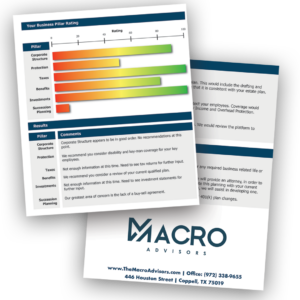- 972-338-9655
- info@themacroadvisors.com
- 446 Houston Street, Suite 200 | Coppell,TX 75019
As an owner you need to consider benefits for yourself as well as your employees. It’s imperative you not only take care and protect your key people, but also take time to look out for yourself.
 Owners invest all they have into a business both emotionally and monetarily. While this is essential to run operations in the years before retirement, this proves to be problematic as an owner nears retirement age. Due to their investments into the business’s assets, owners have less liquid assets available to invest into their own retirement.
Owners invest all they have into a business both emotionally and monetarily. While this is essential to run operations in the years before retirement, this proves to be problematic as an owner nears retirement age. Due to their investments into the business’s assets, owners have less liquid assets available to invest into their own retirement.
Business owners are significantly less likely than a typical employee to have retirement savings outside of their own business. They also retire, on average, at age 73 whereas a typical employee retires around the age of 68.
These owners are significantly less likely than employees to have previous 401(k)s and/or any retirement savings outside of the business, according to the U.S. Small Business Administration (SBA). Due to this, they likely need to save much more than an employee.
To encourage more Americans to save for retirement, there are special tax incentives offered by the government to small business owners who establish a retirement plan. Employers who qualify and start a plan may receive up to $500 per year in tax credits for start-up costs for up to three years.
Selective or non-qualified benefits are important plans an owner must consider. They can not only be used to help fund retirement—they can also help retain key employees.
Owner/executive benefits can help bridge the gap between how much an owner requires in retirement, and how much they have saved.
In today’s competitive workplace recruiting, it’s more important than ever to be able to retain and reward key employees. The loss of one of these valued employees can spell trouble for business operations. It’s important for owners to be aware of the costs associated with the procurement and hiring for key positions. These losses include:
Around 63% of U.S. small business owners indicated that offering an employee benefit package was “influential” towards employee satisfaction and loyalty according to the U.S. Department of Labor.
 Whether hiring new key workers or desiring to retain those crucial to maintaining daily operations, benefit plans are often the leveraging tool that puts an owner ahead of the competition. These days, workers not only need employers’ support in saving for retirement, they have come to expect it.
Whether hiring new key workers or desiring to retain those crucial to maintaining daily operations, benefit plans are often the leveraging tool that puts an owner ahead of the competition. These days, workers not only need employers’ support in saving for retirement, they have come to expect it.
Offering a competitive salary in combination with attractive benefits can promote improved work habits, while reducing employee turnover.
The Center for American Progress found that the cost of turnover for a typical employee would cost the business owner more than one-fifth of the lost employee’s salary to replace them. In addition to the initial recruitment costs, more productivity can be lost in the time it would take to bring a new hire up to speed.

Ready for Your Snapshot?
Uncover the financial blindspots in your business with a complimentary Snapshot Report.
Sign Up for Weekly Tax-Strategy Updates